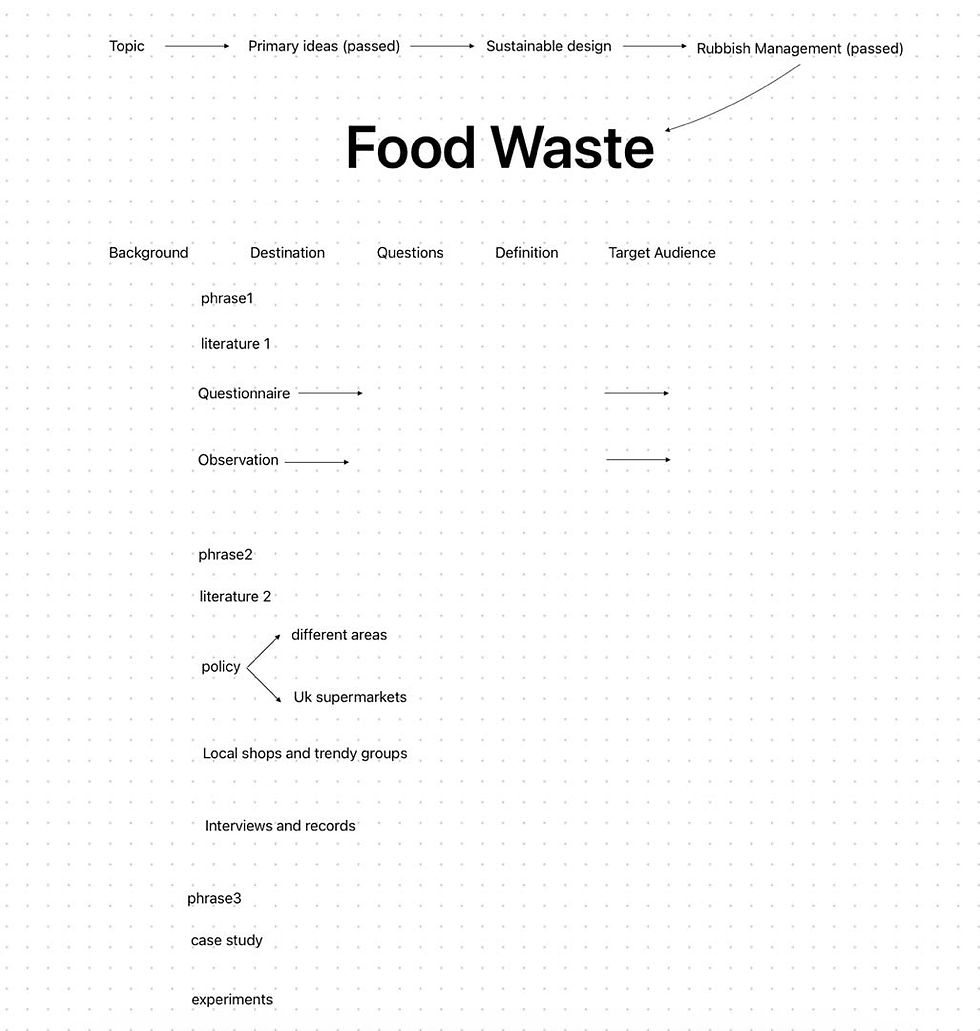Stage Summary (Week6-Week9)
- yiwen yang

- 2023年3月25日
- 讀畢需時 2 分鐘
已更新:2023年3月26日
Research Logic
In this phase, I have been able to fill in the gaps based on the findings of the previous phase - enriching the areas of research that were not perfected in the previous phase, as well as adding more methods of investigation to enrich the original findings.
In the meantime, I carried out follow-up studies based on my teacher's suggestions, which lasted until week9. It was a long process and fortunately I obtained many valuable results, which I will present visually in the coming week (week10-11) and define the objectives of my final research.

About Phase 1- Primary Research
1.Background
1.1 Situation
1.2 Policy
1.3 Problems
2.Definition of the issue
2.1 Social Design
2.2 Sustainable Design
2.3 Food Waste
2.4 Targeted Audience
2.5 Proposal
About Phase 2- Behavior Research
1.Mass Behavior Research 1 (Objective research)
1.1 Questionnaire (Census)
1.2 Focus groups (Interview)
1.3. Literature (Research on food waste in the literature follows the steps of the COM-B model (Capacity, Opportunity, Motivation - Behavior): a framework for describing and designing behavior change interventions and triggering habits. In addition, the study builds on the Theory of Planned Behavior (TPB) and is explicitly used to explore food waste habits.)
2. Mass Behavior Research 2 (Subjective research)
2.1 Observation in Cafe (Gen Z)
2.2 Observation in other Restaurants. (Control groups)
The Main Aim is to understand the attitudes, routines and skills of the target group in relation to food waste in their daily lives. The sustainability framework examines the experiences of Generation Z, the barriers and opportunities associated with behavioral patterns, as well as current habits - in terms of planning, shopping, cooking, eating and storing - and future motivations.
About Phase 3 - "Food Waste Interventions" research.
1. policies in UK and other areas (The relationship between cultural and environmental differences across regions and food waste interventions)
2. Uk: Supermarkets and trendy groups (How individuals operating in the UK region influence consumer behavior, in terms of food waste)
3. " Records your changes. " (After the questionnaire survey, I will select typical cases for one-on-one conversations, and these people will always exist in my follow-up research. At the same time, I ask them to consciously improve food waste, and summarize the reasons for helping themselves to improve their waste behavior on a weekly basis.)
4. Literature (some experiments offered by others, Some reference values can be obtained)
The Main Aim is to contribute to the design outcome: a behavior change application that guides young consumers' behavior patterns in a more sustainable direction.
About Phrase 3 - Visual experiments
1.Visiting exhibitions and galleries
2.Sketching activities
3.Data visualization experiments
4.Personal visual image experiment
5.Case studies
The Main Aim is to find more possibilities for visual expression.



留言